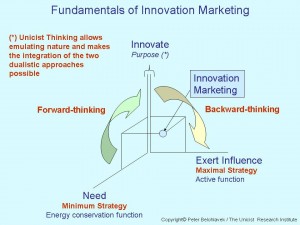The Unicist Standard deals with innovation marketing considering it a unified field that differs from the marketing of non-innovative goods or services. The marketing of innovations is the most complex marketing process that can be imagined.
 Following Maslow, when a need is satisfied a new need arises. Therefore innovation is the core of any growth strategy. But innovation has a double effect in human behavior. On the one hand, it bothers because it requires changing, but on the other hand, it is expected to satisfy the new needs that arouse when the existing demands have been satisfied.
Following Maslow, when a need is satisfied a new need arises. Therefore innovation is the core of any growth strategy. But innovation has a double effect in human behavior. On the one hand, it bothers because it requires changing, but on the other hand, it is expected to satisfy the new needs that arouse when the existing demands have been satisfied.
The maximal strategy to sell innovations is driven by the influence the company or the individual that proposes an innovation has. Fashion is a demonstration of innovation management and of how influence drives its marketing.
The minimum strategy is driven by the need of the innovation. Therefore minimum strategies depend on the capacity of a company to stimulate the need of the new solution that is being proposed. Adequate “promotions” are “need stimulators” that ensure minimum strategies.
Companies usually face two problems when offering innovations to the market:
1) They believe in an hypothetical but not real added value
2) Those who sell are conservative and do not understand innovations
Use what you sell and sell what you use is an antidote for most of the problems.
